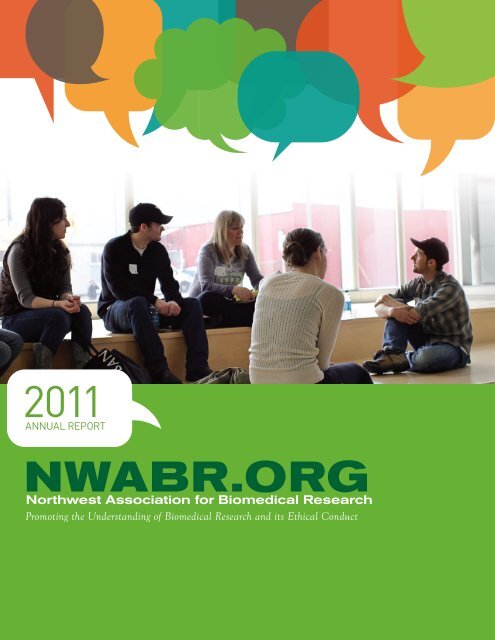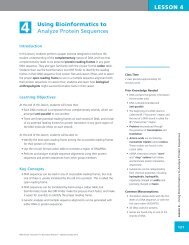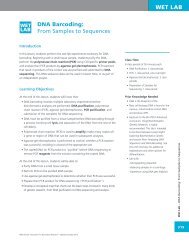2011 Annual Report - Northwest Association for Biomedical Research
2011 Annual Report - Northwest Association for Biomedical Research
2011 Annual Report - Northwest Association for Biomedical Research
- No tags were found...
Create successful ePaper yourself
Turn your PDF publications into a flip-book with our unique Google optimized e-Paper software.
dialogue
From The DirectorNWABR strengthens public trust in research. These wordscapture who we are as a community. They were chosen by ourBoard leadership to define, mobilize and inspire every researchorganization and individual who is a member of NWABR.How does NWABR join <strong>for</strong>ces with our members to carry out this mandate? Read on…NWABR strengthens public trust in research…througheducation and dialogue.This year, we present the impact of our work through the rich kaleidoscope of dialogue.Dialogue has many translations…from Webster’s Dictionary — “a conversation by two ormore persons,” to C. Otto Scharmer’s Four Fields of Conversation — “speaking from seeingmyself as part of the whole” (reflective inquiry).As you peruse the pages that follow, we invite you to take note of the dynamic ways inwhich you engage with us in dialogue across our northwest region…• Speaking• Blogging• Mentoring• Writing and responding to articles and opinion pieces• Hosting on-site visits with passionate, articulate scientists• Judging at our high school Student Bio Expo• Serving on our Task Forces to insure trustworthy research practices• Providing “safe places” that preempt and prepare <strong>for</strong> crisis communications• Participating in our new monthly “Bioethics Salons”—Community ConversationsIn historian Jonathan Moreno’s recent book — The Body Politic: The Battle over Science inAmerica, he demonstrates how the intersection of society and science has shaped moderndaybiopolitics, highlighting embryonic stem cell research and synthetic biology as potentexamples. Moreno makes the argument that scientists today are suspect. The publicbelieves we talk funny and work in secret silos. “It is all about mutual identification”, he statedin a private session in Seattle this fall. “It’s not about the issue. It is about the people with whomone identifies.” Moreno makes a compelling case; scientists are not people with whom thepublic can readily identify.NWABR’s <strong>2011</strong> <strong>Annual</strong> <strong>Report</strong> is replete with example upon example of how we arechanging that perception through the power of dialogue. Thank you <strong>for</strong> your ongoingsupport in partnering with us in this essential work. As always, we hope our report sparksadditional ideas <strong>for</strong> continuing the dialogue and strengthening public support <strong>for</strong> research.Susan AdlerExecutive Director<strong>2011</strong> <strong>Annual</strong> <strong>Report</strong> 3
“Society determines how much of our resources will bedevoted to finding cures <strong>for</strong> the diseases that afflict us.That decision needs to be made with as much knowledgeas possible. By promoting dialog between biomedicalresearchers and the public, NWABR plays a crucial role inin<strong>for</strong>ming the public of the rewards that ensue from theirsupport of biomedical research.”Bob Speth, Emeritus Board memberProfessor of Pharmaceutical SciencesCollege of PharmacyNova Southeastern University4 <strong>Northwest</strong> <strong>Association</strong> <strong>for</strong> <strong>Biomedical</strong> <strong>Research</strong> // www.nwabr.org
Creating a Classroom Atmosphereof Respectful DialogueAnimal research. End of life decisions. Stem cell research.Few topics elicit such strong reactions as these, and many teachers are hesitant to bring controversialsubjects into the classroom. NWABR’s Ethics in the Science Classroom curricula support students incoming to well-reasoned, fact-driven positions about issues such as these. This is no easy task: justifyingsuch a position involves complex cognitive skills that are challenging to both teach and assess.NWABR is making a difference. Our latest curriculum, The Science and Ethics of Animal <strong>Research</strong>, ismaking a national impact and was recently mentioned in The Scientist as an exemplary resource <strong>for</strong>teaching this important topic. <strong>2011</strong> also marked the completion of NWABR’s research study investigatingthe effectiveness of our teacher professional development and our bioethics resources in promotingstudent critical thinking, reasoning, and analysis skills. Students who have experienced our curriculumshow an increased ability to analyze socio-scientific issues and make well-justified decisions, awarenessof ethical issues, understanding of the connection between science and society, and the ability to list anddiscuss viewpoints different from their own. Our findings are currently being prepared <strong>for</strong> publication.Students’ Perspectives Be<strong>for</strong>e and After Participation in NWABR Ethics Unit (self-reported scores)“Students approachthe idea of animals inresearch from a veryemotional perspective.NWABR’s curriculumhelps them explore themany issues surroundinganimal use and step awayfrom the emotions tomake a reasoned logicalevaluation of the realitiesof animals in research.Elise Cooksley, scienceteacher and member ofNWABR’s curriculumdevelopment team”In support and recognition of this vital work, in October NWABR was awarded a $134,000 supplement toour Science Education Partnership Award grant from the National Institutes of Health to offer additionaleducational resources and programs related to the topic of animals in research. 56 secondary scienceeducators participated in a 3-part special seminar series that included tours of animal facilities inmember research institutions, a special workshop led by Primate Center Directors at the NonhumanPrimate Models <strong>for</strong> AIDS Conference and in-depth professional development in NWABR’s recentlyreleased curriculum, The Science and Ethics of Animal <strong>Research</strong>.Bioethics 101Reasoning and JustificationThe Nature of Scientific <strong>Research</strong>Practices and ProcessesThe Science and Ethics ofAnimal <strong>Research</strong>The Science and Ethics ofHumans in <strong>Research</strong><strong>2011</strong> <strong>Annual</strong> <strong>Report</strong> 5
A monthly series that will continue into 2012, our first three events were facilitated by Kelly Edwards,PhD, UW Bioethics and Humanities; Lara Mangravite, PhD Sage Bionetworks; and NWABR’s JenniferWroblewski, MPH in partnership with Heather Kirkwood, VP and Director of Outreach <strong>for</strong> the Hermansky-Pudlak Syndrome Network. Topics encouraged thoughtful dialogue about duty to participate in medicalresearch, how to accelerate research while protecting study participants and special issues within raredisease research illustrated by film excerpts from RARE, co-directed by Maren Grainger-Monsen, MDand Nicole Newnham. NWABR is proud to honor our Community Conversation presenting partners: 415Westlake, Kakáo Chocolate and Coffee, Union and the Institute of Translational Health Sciences.Linking Science Volunteers and the CommunityIncreasing the dialogue between scientists and the public is an important step in breaking down negativestereotypes and planting the seeds of interest in science careers. NWABR serves as a hub connectingresearchers with volunteer opportunities in the community. We initiated an online sign-up <strong>for</strong> volunteersand maintain a current list of community volunteer opportunities (http://nwabr.org/community/volunteeropportunities).NWABR staff and volunteers from our member organizations hosted activity tables atmultiple family science events and judged at science fairs and student presentations.“I’ve never be<strong>for</strong>e thoughtabout the mental healthstruggles people withrare disease might have,or how people might feelbeing in a clinical trial.CommunityConversationParticipant”Blog GrowthIn our first year of blogging, we published more than 75 posts, viewed by over 10,000 readers on our mainblog, “Thank <strong>Research</strong>!” Our most popular posts included coverage of our <strong>2011</strong> Youth Ethics Summitat the Institute <strong>for</strong> Stem Cell and Regenerative Medicine at the University of Washington. Studentsenjoyed “Stem Cells 101″ by Professor Tony Blau, MD and Director of the Institute, extensive tours, andparticipating in discussions about bioethics. Another popular post covered a lecture entitled “HenriettaLacks: Ethics at the Intersection of Health Care and <strong>Biomedical</strong> Science,” given by Dr. Ruth Faden, PhD,MPH, of the Johns Hopkins Berman Institute of Bioethics. Dr. Faden illuminated ethical concerns from thestory of Henrietta Lacks that are still relevant today in patient consent, biorepositories, and participationin research. We have revisited these issues through many other programs, such as NWABR’s CommunityConversations series.Inspiring Students and TeachersExpoWhile science fairs are not typically thought of as a <strong>for</strong>um <strong>for</strong> international communication, the <strong>2011</strong>Student Bio Expo piloted a program which focused on generating conversation between students inSeattle and Kenya. Using technology like Skype and Google Docs as a means to connect, Seattle studentswere inspired by the Kenyan teens, who see first-hand the ravages of HIV, malaria, and tuberculosis,“This experience hasopened my eyes to howimportant education is. Inmy global health team, ourpartners in Kenya providedus with so much more thanwe expected, remindingme that everyone’s voice istruly important. Throughthis project I became moreaware of global diseasesand the importance of”being a global citizen.Roosevelt Student8 <strong>Northwest</strong> <strong>Association</strong> <strong>for</strong> <strong>Biomedical</strong> <strong>Research</strong> // www.nwabr.org
“NWABR hascreated somethingspecial and I amexcited to be apart of it again.”Brianna Armour2006 Expo Participant,2012 Expo mentorthe “unholy trinity of infectious disease.” One Roosevelt High School student commented that she “feltempowered by [her] partners in Kenya, who were so fun and helpful.” The SeaVuria program, named<strong>for</strong> the places where the students lived--Seattle and the village of Vuria, fostered projects that notonly focused on the biological aspects of infectious disease, but also emphasized the importance ofimplementing social programs as a means to help communities in Kenya. By cultivating relationships withstudents on the other side of the world, Expo students learned that there’s a human side to science.Over 300 students presented projects at the 11th Student Bio Expo in <strong>2011</strong>. Two hundred students tookadvantage of the opportunity to be mentored by 135 professionals in scientific or medical fields. Inaddition to the SeaVuria projects, these year-long mentorships contributed to award-winning and crowdpleasingprojects such as a teaching lesson which used pasta to demonstrate natural selection and asoap opera dramatizing the diagnosis of type-1 diabetes to a teenager.“Expo made me look atscience in a whole newway; it was amazing to seeall the projects that peoplecome up with and howthere are so many differentways that things can beconnected to science.”Eastlake StudentOut-of-School (“In<strong>for</strong>mal”) Science Education PartnershipsScience is everywhere and showcasing its relevance in after-school programs has a lasting impact.NWABR staff presented hands-on workshops focused on the science behind lotions to middle and highschool students associated with Girls Scouts, the <strong>Association</strong> <strong>for</strong> Women In Science GEMS program,Expanding Your Horizons and community after-school science programs. Over 250 students and adultsmade lotions and gained an appreciation <strong>for</strong> the importance of reading labels, safety testing of ingredientsand the science of emulsions.NWABR Becomes Partner on Collaborative Digital LibraryWith funding from the NSF, NWABR joined the Archive of Teaching Resources (www.apsarchive.org),a Collaborative National Science Digital Library sponsored by the American Physiological Society.The Archive provides increased national exposure <strong>for</strong> our educational materials, with peer-reviewedresources <strong>for</strong> K-12, undergraduate, graduate, professional, and continuing education. Within the NWABRcommunity, introducing the Archive at teacher professional development events offers the opportunityto engage educators in building curricular sets, rating items in the Archive, and conversation regardingpreferred resources and best practices.Each resource in the Archive has been reviewed <strong>for</strong> scientific accuracy and appropriate use of humans oranimals in teaching. Archive Partners have catalogued more than 4,000 free resources covering a varietyof topics, especially physiology, anatomy, embryology, human biology, invertebrate biology, neuroscience,and career exploration and development. Other partners include Society <strong>for</strong> Developmental Biology,Human Anatomy and Physiology Society, American <strong>Association</strong> of Anatomists, and the MassachusettsSociety <strong>for</strong> Medical <strong>Research</strong>. With over 9000 unique users/month, the Archive is a popular and growingsource <strong>for</strong> accurate educational materials. By including NWABR’s materials in this highly selective peerreviewedDigital Library, we can be a catalyst that deepens the dialogue about research in classroomsacross this country.<strong>2011</strong> <strong>Annual</strong> <strong>Report</strong> 9
Bioin<strong>for</strong>matics Program Summary“I didn’t know how topass on science careerinfo be<strong>for</strong>e but have aplat<strong>for</strong>m to teach it nowthrough this curriculum.I feel more confident inbeing able to advocate<strong>for</strong> students to pursue ascience career.”Bio-ITEST TeacherNow in its third and final year, our NSF-funded bioin<strong>for</strong>matics education program Bio-ITEST: New Frontiersin Bioin<strong>for</strong>matics and Computational Biology provided secondary science teachers with rigorous and up-todatecurricular resources and support, reaching 200 new teachers from around the country through ourprofessional development workshops and regional and national education conferences. NWABR connectedteachers with scientists from our partner and member institutions like Novo Nordisk and the Institute <strong>for</strong>Systems Biology in order to provide unique opportunities <strong>for</strong> teachers to dialogue with scientists; <strong>for</strong> manyteachers, this may be their only opportunity to interact directly with scientists, and bring those experiencesback to their students. This program has had an impact on how teachers communicate with each otherand with their students: teachers have grown their community of practice, dialogue with each other atannual reunions and participate in our online community, and inspire their students to pursue sciencerelatedcareers. The Bio-ITEST research study demonstrated sustained gains among teachers throughoutthe school year in the areas of science career awareness and self-efficacy in using bioin<strong>for</strong>matics toolsand databases in their classrooms. After experiencing our Introductory unit, Using Bioin<strong>for</strong>matics: GeneticTesting, students showed significant gains in their awareness of science careers and self-efficacy usingbioin<strong>for</strong>matics tools. According to the external evaluation team, “The Bio-ITEST project clearly adds to ourbody of knowledge on strategies to prepare young people to enter the STEM work<strong>for</strong>ce of the future.” Theprogram plans to build on these findings and the work of our Emerging Role of Science Teachers in FacilitatingSTEM Career Awareness study through dissemination and scale-up ef<strong>for</strong>ts in the coming year.Junior Science Cafes’Imagine dozens of hands in the air, wiggly bodies barely staying in their seats, and lots of little personalvignettes shared by 3rd, 4th and 5th grade students in Coeur d’ Alene, Idaho on topics related to healthand biomedical research. Now imagine a small group of these same students taking leadership roles tocreate the events — junior science cafes — that brought their peers together <strong>for</strong> these discussions. Providingopportunities <strong>for</strong> these very young students to discuss science in in<strong>for</strong>mal settings, ask questions of interestto them, and develop leadership skills <strong>for</strong> student organizers were the goals of this unique collaborationbetween NWABR and the Idaho Idea Network <strong>for</strong> <strong>Biomedical</strong> <strong>Research</strong> Excellence (INBRE).We believe that inspiring the next generation of citizens and scientists through programs like juniorscience cafés is a vital part of NWABR’s mission to strengthen pubic understanding of biomedicalresearch through education and dialogue. At Ramsey Magnate School of Science the elected studentcouncil representatives in grades 3, 4 and 5 took ownership of the junior science cafes at their school,gave presentations about each event to their classmates, created flyers and posters, introduced thespeakers, took photos, wrote articles <strong>for</strong> their school newspaper, set up each event, and worked with theNWABR and INBRE staff to evaluate the program and plan future sessions.Ultimately, the impacts of NWABR’s junior science cafes go beyond the more than 200 students whoasked their questions, wiggled in their seats and contributed their own stories. Not only did thesestudents learn a bit about science, they interacted directly with scientists, learned about what scientistsdo every day in their laboratories, and gained a sense of the level of commitment scientists have towardmaking the world a better place. Perhaps the most important measure of success is that the kids haveasked us to come back!<strong>2011</strong> <strong>Annual</strong> <strong>Report</strong> 11
“Over the past few years I have truly enjoyed and benefittedfrom the experiences that NWABR has given me. I appreciatethe time you invest in organizing professional developmentthat is worthwhile, educational and makes me feel like aprofessional. I have valued the opportunities to speak withresearchers, doctors and other science professionals aboutscience. I love to actually witness science happening insteadof just reading about science in books. The professionaldevelopment has made me a better teacher because I canshare my first hand experiences with my students andmake science come alive <strong>for</strong> them too. NWABR listens tomy feedback and the feedback of others to ensure that theirprofessional development opportunities are worthwhile toteachers and that is exactly why I keep returning to events.Thanks <strong>for</strong> everything you do!!!”Shani Neamen, science teacher12 <strong>Northwest</strong> <strong>Association</strong> <strong>for</strong> <strong>Biomedical</strong> <strong>Research</strong> // www.nwabr.org
MembersOrganizational MEMBERSHealth-Related CorporationsAmgenEmergent Product DevelopmentPhenoPath LaboratoriesSNBL USA, Ltd.Zymogenetics, a Bristol-Myers Squibb CompanyEducational & <strong>Research</strong> InstitutionsOregon Health & Science UniversityOregon State UniversityUniversity of IdahoUniversity of MontanaUniversity of OregonUniversity of WashingtonWashington State UniversityWestern Washington UniversityNon-Profit <strong>Research</strong> InstitutionsAllen Institute <strong>for</strong> Brain ScienceFred Hutchinson Cancer <strong>Research</strong> CenterInfectious Disease <strong>Research</strong> InstituteInstitute <strong>for</strong> Systems BiologyInstitute <strong>for</strong> Systems MedicinePacific <strong>Northwest</strong> Diabetes <strong>Research</strong> InstitutePacific <strong>Northwest</strong> National LaboratoryPATHPuget Sound Blood CenterSeattle BioMedSeattle Children’s <strong>Research</strong> InstituteThe Hope Heart Institute<strong>Research</strong> HospitalsBenaroya <strong>Research</strong> Institute at Virginia MasonLegacy Health SystemPortland Veteran Affairs Puget Sound Health Care SystemSamaritan Health ServicesSouthwest Washington Medical CenterSt. Luke’s Health SystemSwedish Medical CenterVeterans Affairs Puget Sound Health Care SystemASSOCIATE MEMBERSVoluntary Health OrganizationsMarch of Dimes<strong>Northwest</strong> Kidney CentersProfessional Societies & <strong>Association</strong>sWashington Global Health AllianceWashington State Dental <strong>Association</strong>Washington State Medical <strong>Association</strong>Washington State Veterinary Medical <strong>Association</strong>Services ProvidersAirgas NorpacAlexandria Real Estate Equities, Inc.Allentown, Inc.Christensen O’Connor Johnson Kindness, PLLCLucent Medical SystemsNBBJPurina Mills Lab Diet/Land O’ Lakes Purina FeedQuorum ReviewSuburban SurgicalThe Windward CompanyWestern Institutional Review Board<strong>2011</strong> Executive CommitteePresidentJudy Fenyk-Melody, DVM, DACLAMDirector, PreclinicalAmgenVice PresidentTed Poston, MScSenior <strong>Research</strong> ScientistInstitutional OfficialPacific <strong>Northwest</strong> National LaboratoryVice PresidentCheryl Weaver, CCRC, CCRAAdministrative Director, Clinical <strong>Research</strong>ProgramBenaroya <strong>Research</strong> Institute atVirginia Mason<strong>2011</strong> Board of DirectorsGary T. Chiodo, DMD, FACDChief Integrity OfficerOregon Health & Science UniversityWilliam S. Dernell, DVM, MS,Diplomate ACVSProfessor and Chair, Dept of VeterinaryClinical SciencesWashington State UniversityKelly Edwards, PhDAssociate Professor, Bioethics and HumanitiesDirector, Community Engagement and EthicsCore, Center <strong>for</strong> Ecogenetics andEnvironmental HealthUniversity of WashingtonLinda GainerVice President, External Relations andCommunicationsFred Hutchinson Cancer <strong>Research</strong> CenterMaria Elena GeyerExecutive Vice PresidentPuget Sound Blood CenterJennifer Hansberry, RN, BSNDirector of <strong>Research</strong>Swedish Medical CenterJan Jacobs, CFREDirector of Donor RelationsPATHJames LaddSenior VP <strong>for</strong> Finance & OperationsInstitute <strong>for</strong> Systems BiologyBrad Leathley, AIAPrincipalHigher Education and <strong>Research</strong> Facility DesignNBBJTreasurer/Chair, Finance CommitteeBob EnnesDirector, Health Sciences AcademicServices & FacilitiesInterim Director, Finance & Administration,Health Sciences AdministrationSecretaryCami Gearhart, JDCEOQuorum ReviewImmediate Past PresidentLynn Rose, PhDAssociate Director, Center <strong>for</strong> ClinicalTranslation <strong>Research</strong>Seattle Children’s <strong>Research</strong> InstituteTina MankowskiAssociate Vice President <strong>for</strong> Medical AffairsUniversity of WashingtonRoyce Morrison, MD, CPIChief Medical OfficerComprehensive Clinical DevelopmentTodd MyersPrincipalTodd Myers CommunicationsTina Quinton, JD, MSAssociateChristensen O’Connor Johnson Kindness PLLCStephen Rosenfeld, MD, MBAFreeport <strong>Research</strong> ConsultingLynette Schenkel MMAssistant Vice PresidentOffice of Responsible ConductUniversity of OregonCharlotte Shupert, PhD, CIPDomain Analyst, ComplianceCayuse, INc.John Slattery, PhDVice DeanOffice of <strong>Research</strong> & Graduate EducationUniversity of Washington School of MedicineBenjamin Wilfond, MDDirector, Treuman Katz Center <strong>for</strong> PediatricBioethicsSeattle Children’s <strong>Research</strong> InstituteProfessor and Chief, Division of Bioethics andDepartment of PediatricsUniversity of Washington School of Medicine14 <strong>Northwest</strong> <strong>Association</strong> <strong>for</strong> <strong>Biomedical</strong> <strong>Research</strong> // www.nwabr.org
















